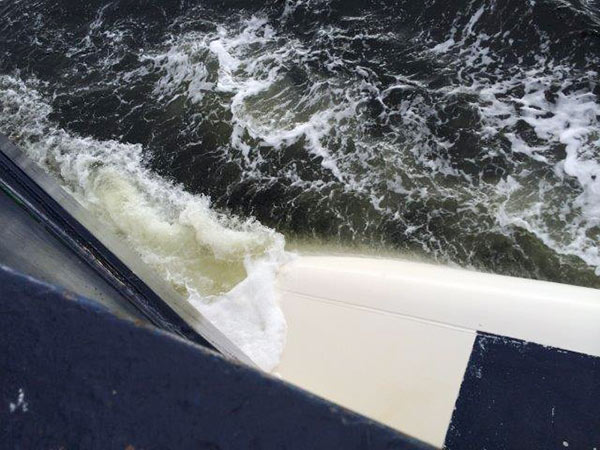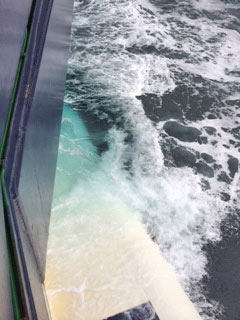EMMA 20140725
|
It is approaching breakfast. It is 0700 and I am now joined by three people in the lab. The early morning hours have been more quiet than usual on the night watch. I have been busy with filtrations. Have the two 1000L tanks filled with water that I am filtering on the large glass fibre filters. I am catching up with quite a few samples of filtering on Teflon filters. Only five to fifteen liters – but takes a few hours anyhow. The system for filtrating dissolved things in the water (SPE) has been running all night. Take around five hours per sample, and they have also been piling up since the last days of heavy sampling. I am marking the sample standing on the floor here with submersible pump sample no.8. It feels like quite an achievement to have taken so many pump station samples alongside the regular sea water from the surface intake. When you have three filtration systems running in parallel with two systems of twin samplers (where you can run two samples at once) it is really important to be adamant about marking your samples, getting the names, times, salinity and temperature readings as well as flow rates, pressure, and volumes filtered right. When the stations are coming up with three-four hour intervals the concentration needs to be top notch. We started filtrations from the sea water intake some half hour or so before station – running this during station time and keeping it on until half an hour after station. Right when approaching station you need to communicate with the bridge to know when the submersible pump can be lowered into the water – and if we are waiting for a goflo bottle to go down first for sampling of water on the bottom for water methane age determination. The Goflo-setup also uses the red winch. Today someone told me I was very efficient and clear in my radio communication with the bridge. That was a nice compliment. I think this part is important. I will normally alert the bridge that I intend to put something in the water around fifteen min before deploying. Then just when we are ready to get your equipment into the surface of the ocean, and also when the equipment, in our case the submersible pump is left at the right depth, and at what depth this is so they know what is out over the reeling of the ship – and how long I intend to have it stay there. The filling of the 1000L tanks take around 2 hours, but we have had too short time between stations to filter that much water so we have filled just a little more than one tank now. Samples that were piling up are now in the freezer or fridge. Martin is on his shift now – I am off to bed, and we are now taking a deep station – 3000 m. (imagine this – 3 km of water underneath us right now) Currently the CTD with the Niskin bottles to sample water at different depths is in the water – after a heroic night watching Karen and Göran with replacing a vital part of it that had a problem before last station. Most people were tired today from the mid-cruise dinner yesterday, but I was not actually. It fitted my shift times well, and I was awake as usual in the night. I had samples running in the lab so I was in and out of the mess and the lab in my dress-up clothes. Not the usual waterproof gear and proper steel toe shoes. I and many others really enjoyed the sit-down dinner and long chats and mingle after it. It was a very welcome break after intense periods. It was also marked by the hard work put down here, many were working until a few minutes before the dinner. Like me. I “threw” myself in the shower just minutes before I was to go down to the mess. Dried my hair, dressed up in nicer clothes and joined the others. Thank you everyone for a great evening! It was well deserved and there were no stations in the night watch planned – first one now in the morning, so almost everyone could join in. I send a thought to Nina and Denis up on the multibeam team on the bridge, as well as Karen and Göran that worked hard on getting the CTD into shape again!
|
| by Emma Karlsson |
















